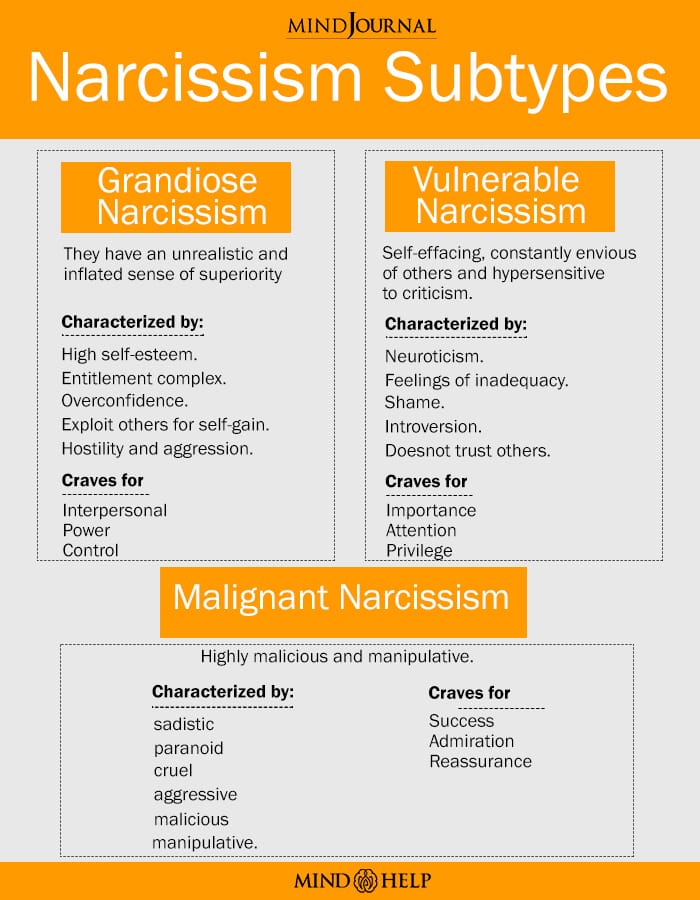In recent years, our obsession with narcissism has skyrocketed, fueled by our intrigue with the various types of narcissists—those individuals who exhibit self-centeredness and egotism.
However, the complexity of narcissism has led to varied descriptions and a search for an understanding of the different types of narcissists.
Let’s delve into the world of narcissism, exploring its types, and signs, and shedding light on this intriguing personality trait.
Read more here: The Self Aware Narcissist: Are Narcissists Aware Of Their Behavior?
Understanding Narcissism
Derived from the Greek mythological character Narcissus, who fell in love with his own reflection, narcissism encompasses a range of personality traits characterized by grandiosity, entitlement, and callousness.
Narcissists are individuals who exhibit high scores on these traits, but not all of them meet the diagnostic criteria for Narcissistic Personality Disorder (NPD), a mental health condition affecting around 1% of the population.
Types Of Narcissism
When discussing narcissism, it is important to distinguish between trait narcissism and Narcissistic Personality Disorder. Two main types of trait narcissism have been identified: grandiose narcissism and vulnerable narcissism.

Grandiose Narcissism
Grandiose narcissism is characterized by an inflated self-perception, a desire for dominance, and tendencies toward aggression. Individuals with grandiose narcissism often display traits like arrogance, entitlement, exploitativeness, and a lack of empathy.
This type is linked to agentic extraversion, which encompasses traits such as authoritativeness, grandiosity, and exhibitionism.
Vulnerable Narcissism
Vulnerable narcissism is marked by increased emotional sensitivity and a defensive, insecure form of grandiosity that conceals underlying feelings of inadequacy.
It involves traits associated with antagonism, including arrogance, entitlement, exploitativeness, and a lack of empathy.
Additionally, vulnerable narcissism is characterized by narcissistic neuroticism, which is linked to fragile self-esteem, a propensity for negative emotions, and shame.
Read more here: Breaking The Chains: How To Break A Trauma Bond with A Narcissist And Reclaim Your Sanity!
Signs Of A Narcissist
Identifying a narcissist can be challenging, but understanding common signs can provide valuable insights. Here are some indications that someone may exhibit narcissistic tendencies,

1. Exaggerated Sense Of Self-Importance
Narcissists often display an inflated sense of self-importance, believing they are superior to others in various aspects of life.
2. Constant Need For Admiration
Individuals with narcissistic traits crave constant attention, admiration, and validation from others, seeking reassurance of their perceived superiority.
3. Lack Of Empathy
Narcissists typically struggle to empathize with others, demonstrating an inability or unwillingness to understand and share the feelings of those around them.
4. Exploitative Behavior
Manipulation and exploitation are common characteristics of narcissists. They may exploit others for personal gain without regard for the well-being of those they exploit.
5. Fragile Self-Esteem
Despite their grandiose exterior, narcissists often have fragile self-esteem, which can be easily damaged. Criticism or rejection may trigger intense negative reactions.
6. Boundary Violations
Narcissists tend to disregard personal boundaries, often intruding upon others’ privacy or disregarding their needs and desires.
Read more here: Understanding Narcopathy: 20 Signs of a Narcopath (Narcissist-Sociopath Mix)
Emphasizing Individuality And Avoiding Stigmatization:
While understanding the various types of narcissism can provide insights into certain behaviors and patterns, it is essential to avoid overgeneralizing or stigmatizing individuals.
Diagnostic labels can carry a social stigma, potentially deterring individuals from seeking mental health support. It is crucial to approach the topic of narcissism with sensitivity and understanding.
In conclusion, narcissism encompasses a collection of personality traits characterized by grandiosity, entitlement, and callousness.
While there are two main types of trait narcissism, grandiose and vulnerable, not all narcissists meet the criteria for Narcissistic Personality Disorder.
Recognizing signs of narcissistic behavior can help identify individuals who exhibit narcissistic tendencies.
However, it is important to approach this topic with empathy and understanding to promote a more inclusive and supportive environment for mental health discussions.









Leave a Reply
You must be logged in to post a comment.